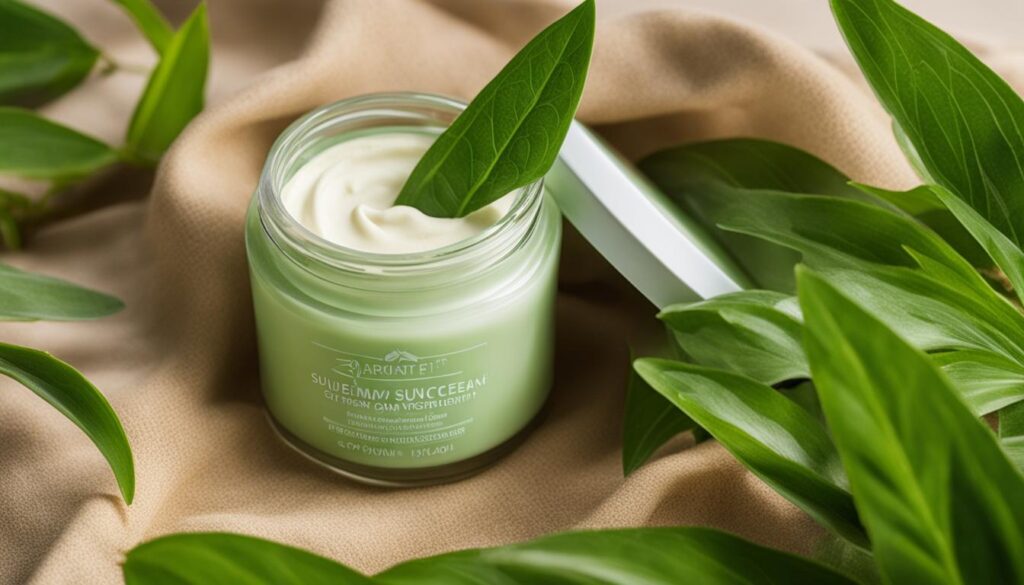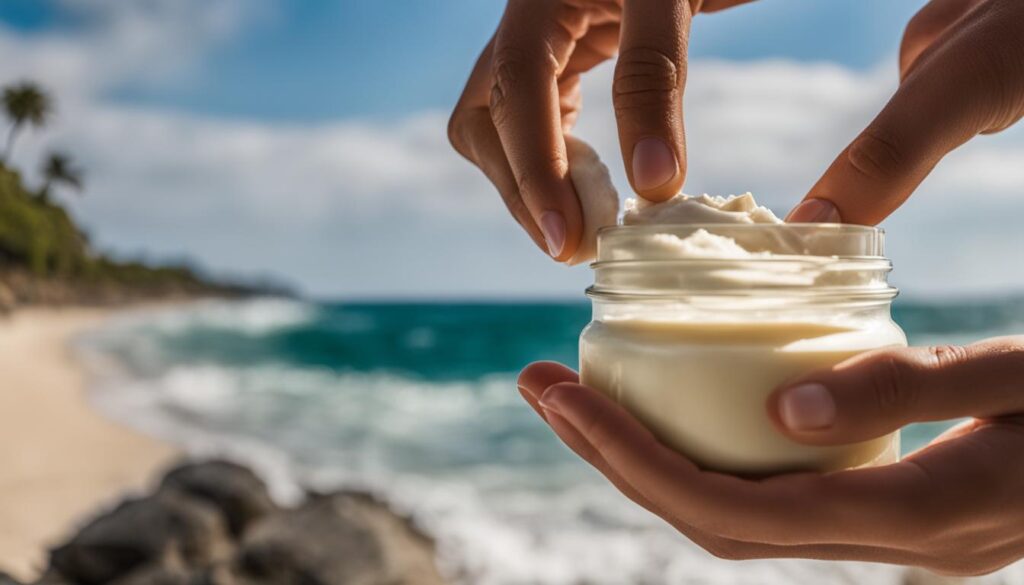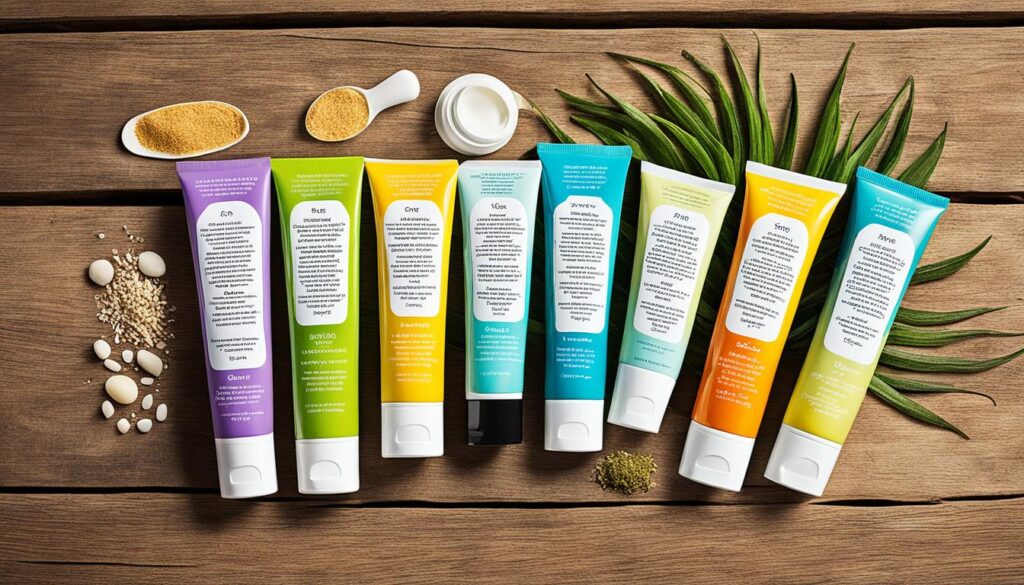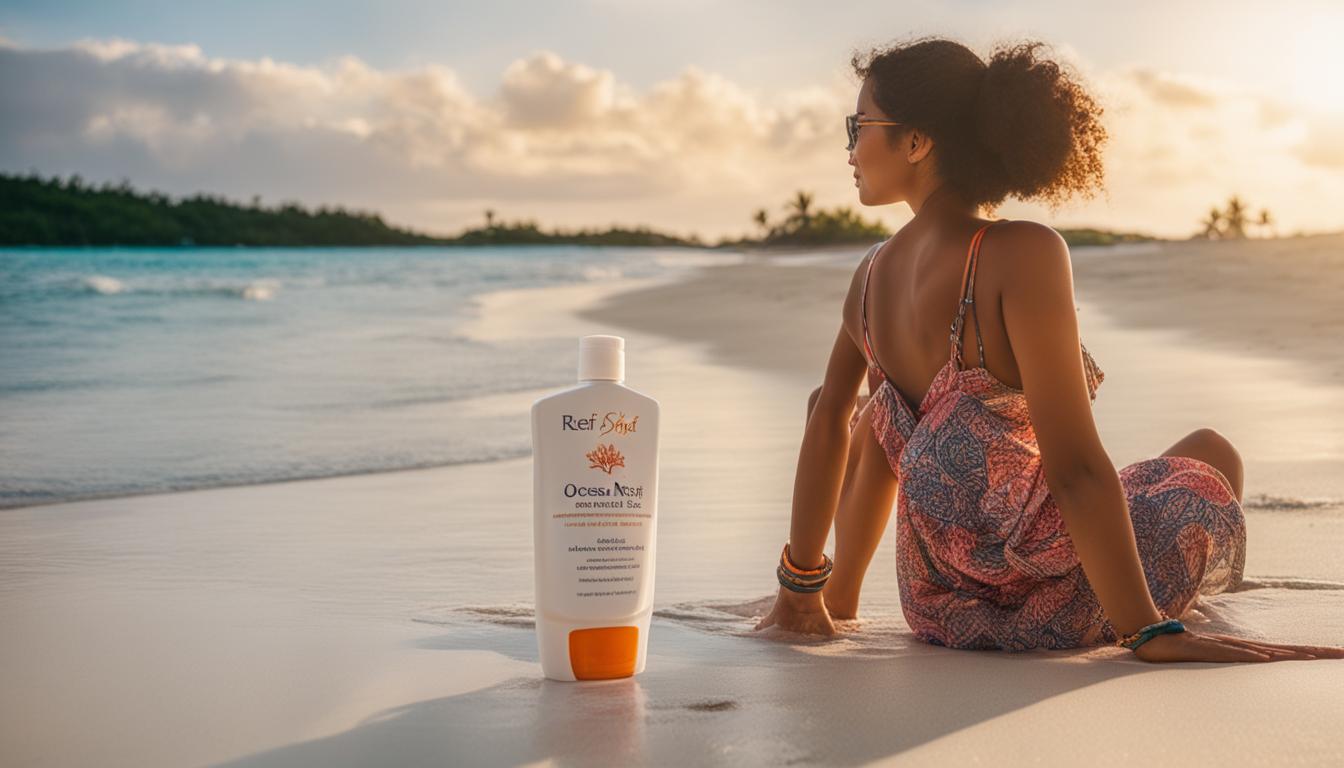Making your own sunscreen is a responsible and eco-conscious choice that helps protect both your skin and the environment. Commercial sunscreens often contain harmful ingredients that can harm both humans and marine life. By creating your own reef-safe sunscreen, you can ensure a safer and more sustainable sun protection option.
Key Takeaways:
- Ocean-friendly sunscreens protect both your skin and the environment.
- Commercial sunscreens can contain harmful ingredients.
- DIY reef-safe sunscreens offer a safer and more sustainable option.
- Making your own sunscreen allows you to control the ingredients.
- DIY sunscreens are made with natural, eco-friendly ingredients.
The Harmful Effects of Traditional Sunscreens
Traditional sunscreens contain harmful ingredients that can have adverse effects on both our bodies and the environment. Chemical-based sunscreens, also known as synthetic sunscreens, rely on chemicals such as oxybenzone, octinoxate, and octisalate to absorb ultraviolet (UV) light. While they effectively protect against sunburn, these chemicals can pose risks to both humans and marine life.
The Dangers of Chemical-Based Sunscreens
Chemical-based sunscreens have been found to mimic hormones and disrupt the endocrine system in both humans and animals. Oxybenzone, in particular, is a common ingredient in many sunscreens, but research suggests that it can have estrogenic effects and may be linked to hormone-related health issues. Furthermore, these harmful chemicals can also harm the delicate balance of marine ecosystems when they enter the water.
Chemical-based sunscreens contain ingredients that can disrupt the endocrine system and have negative consequences for our health and the environment.
The Problem with Mineral-Based Sunscreens
Mineral-based sunscreens provide an alternative to chemical-based options by using minerals like zinc oxide and titanium dioxide to create a physical barrier against UV rays. These minerals work by reflecting and scattering the sunlight away from the skin. However, if the particles in mineral-based sunscreens are small enough to be absorbed into the pores, they can pose risks, including the potential for organ damage.
Reef-Safe Sunscreens
Avoiding harmful sunscreen ingredients is crucial for protecting both ourselves and the delicate reef ecosystems. Oxybenzone, in particular, has been linked to coral bleaching and deformities in reefs. By opting for reef-safe sunscreens, which are free from these harmful chemicals, we can play a part in safeguarding our oceans.
To make informed decisions about sunscreen choices, it’s essential to understand the potential harm that certain ingredients can cause and the impact they can have on our health and the environment. Switching to mineral-based or reef-safe sunscreens is a step towards responsible sun protection that benefits both us and the natural world around us.
Benefits of DIY Ocean-Friendly Sunscreen
Making your own homemade sunscreen offers numerous benefits, both for your skin and the environment. By creating your own eco-friendly sunscreen, you have control over the ingredients used, ensuring they are safe and free from harmful chemicals. Natural sunscreen recipes often include ingredients like coconut oil, beeswax, and non-nano zinc oxide, which provide effective sun protection without the negative effects associated with commercial products.
DIY sunscreens are a sustainable choice that aligns with responsible sun protection practices. By opting for homemade formulas, you can contribute to a more eco-friendly approach to sun protection and reduce your environmental footprint.
Creating your own ocean-friendly sunscreen allows you to control what goes into your product, ensuring it is tailored to your specific needs. Plus, it’s a fun and creative way to take care of your skin while being conscious of the planet.
Benefits of DIY Ocean-Friendly Sunscreen:
- Control over ingredients
- Safety for both skin and environment
- Effective sun protection without harmful chemicals
- Contribution to sustainable and eco-friendly practices
With homemade sunscreens, you can truly have the best of both worlds – sun protection that is not only effective but also safe for you and the planet.

A beautiful day at the beach, protected by your own homemade sunscreen.
DIY Ocean-Friendly Sunscreen Recipe
Creating your own ocean-friendly sunscreen is a simple and rewarding process. By making homemade sunblock, you can ensure that you are using safe, eco-friendly ingredients that provide effective sun protection. Follow the recipe below to make your very own responsible sunscreen:
| Ingredients | Measurements |
|---|---|
| Non-nano zinc oxide | 2 tablespoons |
| Coconut oil | 1/4 cup |
| Shea butter | 1/4 cup |
| Beeswax pellets | 2 tablespoons |
| Essential oils (optional) | A few drops for fragrance |
To make your DIY sunscreen, follow these simple steps:
- Melt the coconut oil, shea butter, and beeswax pellets together in a double boiler or a glass bowl placed over a pot of boiling water. Stir until fully melted and combined.
- Add the non-nano zinc oxide powder to the melted mixture. Make sure to wear a mask and gloves to avoid inhaling or directly touching the powder.
- Stir the mixture thoroughly to ensure the zinc oxide is evenly distributed.
- If desired, add a few drops of your favorite essential oils for a pleasant fragrance. Lavender, chamomile, and peppermint are popular choices.
- Pour the mixture into a clean, airtight container, such as a small jar or tin.
- Allow the sunscreen to cool and solidify completely before use.

Instructions for Making DIY Sunscreen
Creating your own ocean-friendly sunscreen is a rewarding and straightforward process. With a few key ingredients and some simple steps, you can have a safe and effective homemade sunscreen at your fingertips. Here’s how:
Gather the Ingredients:
Before you begin, make sure you have the following ingredients:
- Non-nano zinc oxide powder – provides sun protection.
- Coconut oil – a moisturizing base.
- Shea butter – adds creaminess and extra nourishment.
- Beeswax – helps solidify the mixture.
- Essential oils (optional) – for fragrance and added benefits.
Step-by-Step Instructions:
- In a double boiler or a heat-safe bowl placed over a pot of hot water, combine ¼ cup of coconut oil, ¼ cup of shea butter, and 2 tablespoons of beeswax. Heat the mixture over low heat until everything melts together, stirring occasionally.
- Add 2 tablespoons of non-nano zinc oxide powder to the mixture and stir well to ensure it is fully incorporated. Zinc oxide is what provides the sunscreen’s sun-blocking abilities.
- If desired, add a few drops of your favorite essential oils for fragrance. Lavender, chamomile, or peppermint are popular choices.
- Once everything is mixed thoroughly, carefully pour the mixture into a container or an empty sunscreen tube and allow it to cool completely.
- Your homemade sunscreen is now ready to use! Apply it to your skin generously before heading out into the sun, and remember to reapply every two hours or after swimming or sweating.
It’s important to note that homemade sunscreens have a shorter shelf life compared to commercial products. Store your DIY sunscreen in a cool, dry place and use it within three to six months.
Now that you have your own ocean-friendly sunscreen, you can enjoy the sun while keeping your skin and the environment safe!
SPF Levels in Homemade Sunscreens
The sun protection factor (SPF) of homemade sunscreens can vary based on the amount of each ingredient used. The higher the SPF level, the greater the protection against harmful UV rays. It’s important to note that homemade sunscreens may not offer the same level of sun protection as commercial products, so it’s essential to apply them generously and frequently.
| Ingredient | Approximate SPF Level |
|---|---|
| Coconut Oil | 2-8 |
| Shea Butter | 3-6 |
| Raspberry Seed Oil | 30-50 |
| Carrot Seed Oil | 35-40 |
| Non-Nano Zinc Oxide | 2-20 |
These SPF levels are approximate and may vary depending on factors such as the quality and concentration of ingredients used. It’s important to consult reliable sources and consider your skin type and sun exposure when determining the appropriate SPF level for your homemade sunscreen.
Remember, regardless of the SPF level, it’s essential to practice other sun protection measures such as seeking shade, wearing protective clothing, and minimizing sun exposure during peak hours to ensure comprehensive sun protection.

By understanding SPF levels and using appropriate ingredients, you can create homemade sunscreens that offer effective protection against the sun’s harmful rays. Experiment with different recipes and find the combination that works best for you, keeping in mind the importance of responsible sun protection for both yourself and the environment.
Benefits of Natural Ingredients in DIY Sunscreen
Using natural ingredients in your DIY sunscreen provides additional benefits. Oils like coconut oil, olive oil, and avocado oil contain nutrients that can nourish and moisturize the skin while providing sun protection. Non-nano zinc oxide, a common ingredient in DIY sunscreens, creates a physical barrier against UV rays without being absorbed into the skin. These natural ingredients offer a safer and healthier alternative to the chemicals found in commercial sunscreens.
Coconut oil is rich in fatty acids that help retain moisture in the skin, keeping it hydrated and supple. It also contains natural antioxidants that can help reduce inflammation caused by sun exposure. Olive oil, known for its moisturizing properties, forms a protective layer on the skin, preventing moisture loss and promoting skin elasticity. Avocado oil, packed with vitamins and antioxidants, nourishes the skin and promotes a youthful appearance.
“Using natural ingredients in DIY sunscreen not only protects my skin from the harmful effects of the sun but also ensures that I’m using products that are safe for me and the environment.” – Emily, DIY sunscreen enthusiast
Non-nano zinc oxide, a mineral ingredient, is a key component of natural sunscreens. Unlike nano-sized zinc oxide particles that can be absorbed into the skin and potentially cause harm, non-nano zinc oxide sits on the surface of the skin, reflecting and scattering UV rays. It provides broad-spectrum protection against both UVA and UVB rays and is gentle enough for sensitive skin. By choosing non-nano zinc oxide, you can enjoy the benefits of effective sun protection without the risk of harmful absorption.
By harnessing the power of natural oils and non-nano zinc oxide, DIY sunscreens offer a holistic approach to sun protection. You can have peace of mind knowing that you’re not only safeguarding your skin but also making a positive impact on the environment.
| Natural Oils | Skin Benefits |
|---|---|
| Coconut Oil | Moisturizes and nourishes the skin, reduces inflammation |
| Olive Oil | Forms a protective layer, prevents moisture loss, promotes skin elasticity |
| Avocado Oil | Rich in vitamins and antioxidants, nourishes the skin |

Environmental Impact of Commercial Sunscreens
Commercial sunscreens have a significant environmental impact, especially on marine life and coral reefs. The chemicals, specifically oxybenzone, found in these products wash off into the water and contribute to coral bleaching and reef deformities. Oxybenzone can disrupt hormones in marine organisms and lead to long-term damage to underwater ecosystems. By choosing to make your own ocean-friendly sunscreen, you can minimize your contribution to this environmental harm.
Toxicity to Marine Life
The toxic ingredients in commercial sunscreens, such as oxybenzone, pose a threat to marine life. When these sunscreens are washed off into the water, the chemicals can be absorbed by marine organisms, causing hormonal disruptions and impairing their reproductive abilities. Additionally, the ingestion of these toxic substances by marine creatures can lead to organ damage and even death. Protecting marine life starts with choosing reef-safe sunscreens or making your own ocean-friendly alternatives.
Coral Reef Damage
Coral reefs are delicate ecosystems that are highly vulnerable to the impact of commercial sunscreens. The chemicals in these products, particularly oxybenzone, can trigger coral bleaching, which is the loss of color and vitality in coral reefs. Bleached corals are more susceptible to diseases and are less likely to recover, resulting in long-term damage to the reefs. By adopting reef-safe sunscreens or creating your own natural sun protection, you can help preserve the beauty and biodiversity of these essential underwater habitats.
Choosing an ocean-friendly sunscreen ensures that you can protect yourself from the sun’s harmful rays while also safeguarding the health of marine ecosystems. By taking this small step, you contribute to the preservation of our oceans, making a positive impact on the environment and future generations.
Making Sustainable Choices for Sun Protection
Making your own ocean-friendly sunscreen is a responsible choice for sustainable sun protection. However, it’s important to consider other eco-friendly options and responsible consumer choices to minimize the environmental impact of sunscreens.
When shopping for sun protection products, look for options that are labeled as reef-safe and contain natural ingredients. Reef-safe sunscreens are formulated without harmful chemicals like oxybenzone and octinoxate, which can harm marine life and coral reefs.
Additionally, choosing sunscreens with natural ingredients not only benefits the environment but also provides nourishment and moisturization for your skin. Coconut oil, olive oil, and avocado oil are examples of natural oils that offer sun protection properties while keeping your skin healthy.
Remember, sun protection extends beyond sunscreen. Wearing protective clothing, seeking shade, and limiting sun exposure during peak hours are simple yet effective ways to reduce your environmental footprint and contribute to responsible sun protection.
By making sustainable choices and adopting eco-friendly sunscreen options, you can enjoy the sun while preserving the health of our oceans and planet.
Benefits of Making Sustainable Sun Protection Choices:
- Preserves the health of marine life and coral reefs.
- Reduces the use of harmful chemicals found in traditional sunscreens.
- Nourishes and moisturizes the skin with natural ingredients.
- Minimizes the environmental footprint of sun protection practices.
- Supports responsible consumer choices and promotes sustainable living.
“Protecting the environment begins with responsible consumer choices.”
Making sustainable choices for sun protection not only benefits our own health but also ensures the long-term preservation of our oceans and ecosystems. By opting for reef-safe sunscreens and embracing eco-friendly alternatives, we can enjoy the sun responsibly while protecting the delicate balance of marine life and coral reefs.
Alternatives to DIY Sunscreen
If DIY sunscreen isn’t your preference, there are several reef-safe sunscreen brands available in the market that prioritize sustainability and provide effective sun protection without harming the health of our oceans. Look for products from reputable brands such as Sun Bum, Badger Balm, and All Good. These brands offer eco-friendly options that are formulated without harmful chemicals, making them a great choice for those seeking a convenient and reliable sun protection solution.
Conclusion
Making your own ocean-friendly sunscreen is a responsible and eco-conscious choice that ensures both your skin and the environment are protected. By using natural ingredients and avoiding harmful chemicals, you can create a sunscreen that is safe for you and marine life. Whether you choose to DIY or opt for reef-safe sunscreen brands, taking responsible sun protection measures is crucial for a healthier planet.
Creating your own DIY reef-safe sunscreen allows you to have complete control over the ingredients, ensuring they are safe and sustainable. Natural ingredients like coconut oil, beeswax, and non-nano zinc oxide provide effective sun protection without the harmful chemicals found in commercial products. By choosing to make your sunscreen, you contribute to a more sustainable and eco-friendly approach to sun protection.
Remember, responsible sun protection goes beyond sunscreen. It includes seeking shade, using protective clothing, and limiting sun exposure during peak hours. By adopting these practices and making conscious choices, you can minimize the environmental impact and create a positive change.
Whether you embrace the DIY route or prefer to purchase reef-safe sunscreen brands, the key is to be proactive in protecting both yourself and the ocean. By making responsible sun protection choices, you play a vital role in preserving the beauty of our natural habitats for future generations to enjoy. Stay sun-safe, stay environmentally conscious, and make a difference with your sunscreen choices!
FAQ
What are the harmful effects of traditional sunscreens?
Traditional sunscreens often contain chemicals like oxybenzone, octinoxate, and octisalate, which can have harmful effects on both our bodies and the environment. These chemicals have been found to mimic hormones, disrupt the endocrine system, cause coral bleaching, and deformities in reefs.
What are the benefits of DIY ocean-friendly sunscreen?
DIY ocean-friendly sunscreen allows you to control the ingredients and ensure they are safe for both your skin and the environment. These homemade sunscreens are often made with natural ingredients like coconut oil, beeswax, and non-nano zinc oxide, providing effective sun protection without the harmful chemicals found in commercial products.
How can I make my own ocean-friendly sunscreen?
Making your own ocean-friendly sunscreen is a simple process that requires a few key ingredients. You can find a step-by-step recipe and instructions in the “DIY Ocean-Friendly Sunscreen Recipe” section above.
What are the SPF levels in homemade sunscreens?
The SPF levels of homemade sunscreens can vary based on the amount of each ingredient used. Common oils and ingredients like coconut oil, olive oil, and avocado oil have approximate SPF levels of 4-10. Non-nano zinc oxide, a common ingredient in DIY sunscreens, provides additional sun protection.
What are the benefits of natural ingredients in DIY sunscreen?
Natural ingredients like coconut oil, olive oil, and avocado oil contain nourishing properties that can moisturize the skin while providing sun protection. Non-nano zinc oxide creates a physical barrier against UV rays without being absorbed into the skin, offering a safer alternative to the chemicals found in commercial sunscreens.
What is the environmental impact of commercial sunscreens?
Commercial sunscreens, particularly those containing oxybenzone, have a significant environmental impact. When these products wash off into the water, the chemicals can contribute to coral bleaching and deformities in reefs. Oxybenzone can also disrupt hormones in marine organisms and cause long-term damage to underwater ecosystems.
How can I make sustainable choices for sun protection?
Aside from making your own ocean-friendly sunscreen, you can seek out reef-safe and eco-friendly sunscreen brands. Additionally, using protective clothing, seeking shade, and limiting sun exposure during peak hours can further reduce your environmental footprint and promote responsible sun protection.
What are the alternatives to DIY sunscreen?
If DIY sunscreen isn’t your preference, there are several reef-safe and eco-friendly sunscreen brands available in the market. Look for products from brands like Sun Bum, Badger Balm, and All Good, which prioritize sustainability and reef safety while providing effective sun protection.
What are the benefits of making your own ocean-friendly sunscreen?
Making your own ocean-friendly sunscreen allows you to protect yourself from harmful sun rays while being mindful of the environment. By using natural ingredients and avoiding harmful chemicals, you can create a sunscreen that is safe for both you and marine life, contributing to a healthier planet for future generations.

